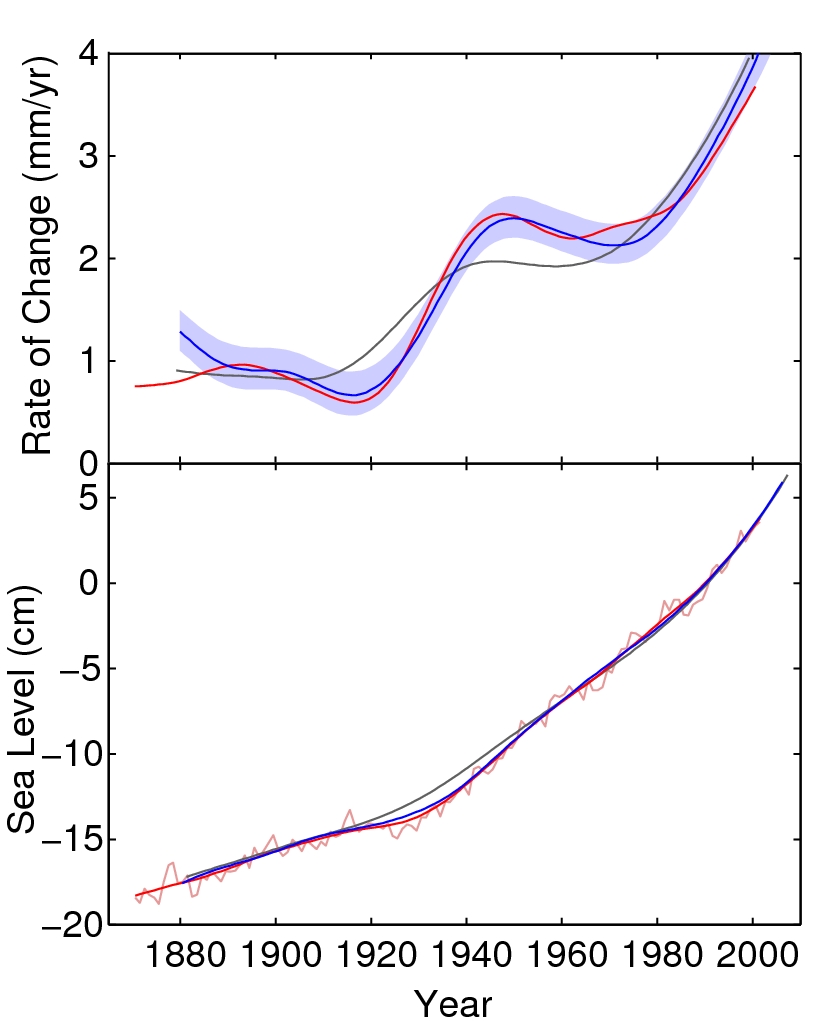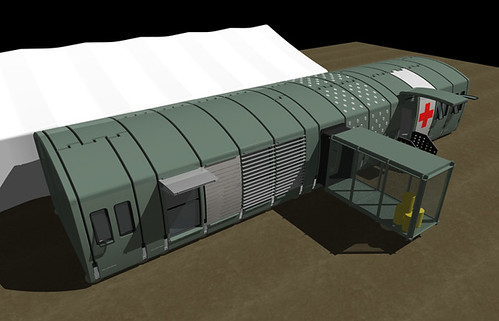Guest commentary by Martin Vermeer
On December 7, 2009 the embargo expired, and my and Stefan’s joint paper
‘Global sea level linked to global temperature’ appeared in the Proceedings of the U.S. National Academy of Sciences. It had been a long time coming! But this post is not so much about the science as about the process, and about how a
geodesist from
Helsinki and an oceanographer from
Potsdam, who to this day have never even met, came to write, to the surprise of both of us, a joint paper on sea level rise.
My own entry into climatology happened only a few years ago. A significant trigger was RealClimate, which I had learned to appreciate as one of the rare reliable Internet sources amidst the junk. Contributing to the oft-slandered science is my small ‘thank you’ and revenge as a scientist.
As I remember, it was the commenter calling himself Rod B. who enquired, sometime August 2008, what the story really was with
Rahmstorf (2007). Trying to answer, I ended up reading the paper and getting interested. What seduced me was the simplicity of this, so-called semi-empirical approach: linear regression of sea level rise
dH/
dt against temperature
T, yielding two unknown parameters: a regression coefficient
a, and an intercept, or ‘equilibrium temperature’,
T0. See our
Ups and downs of sea level projections for a more detailed explanation.
The curve of temperature as a function of time over the 20th century has three parts: a steep rise in the beginning, a flat middle part commonly attributed to aerosols, and a very steep upswing at the end. Physically one would expect for the curve of the sea level rise rate dH/dt as a function of time to look rather similar, as indeed it does: this justifies the Rahmstorf (2007) approach of regressing the one against the other. Looking more carefully however one sees that the
dH/
dt curve has slightly more of an S-like shape, turning downward in the middle, before swinging up again at the end.
This suggested to me that, in addition to a proportionality to temperature
T, sea level rise would also contain a term proportional to the time derivative of temperature,
dT/
dt. In other words, global sea level would be a good global thermometer, but with a ‘quirk’. I could even think of a physical mechanism for such behaviour.
I contacted Dr. Rahmstorf, proposing the idea: one would expect the ocean surface to warm up rapidly to completion, contrary to the deep ocean and the continental ice sheets. This would argue for a term, in addition to the secular
a (
T –
T0) term, of form
b dT/
dt. Stefan’s response was cautious; not surprising, as being something of a media figure in Germany surely means that he has to contend with his share of cranks. But he suggested I look myself into the idea, which I subsequently did: in for a penny, in for a pound.
I downloaded Stefan’s script, modified it, did the first computations with the same real tide gauge and temperature data Stefan had used — surprise: negative
b. Hmmm, strange. That was for real data from the real Earth; what would happen if I applied the extended relationship to simulated data from the same
general circulation model (actually, an
Earth system model) for the period 1900-2100 that Stefan had used in his paper for testing his relationship? This model was in one essential way very much simpler than reality: it completely lacked the contribution of land ice melting to sea level.
Stefan helpfully sent me Matlab snippets and model output, and indeed I got it all working. What was more, the disagreement found by Stefan for the late 21st Century — between sea level rise as predicted directly by the model, and indirectly through the semi-empirical relationship between temperature and sea level rise — went almost completely away when using the new, extended relationship. With a positive value for
b, just as expected from theory for an ocean surface water response.
 |
Global sea level against time. Top, sea level rise, bottom, sea level itself. Red, sea level from observations; blue, with uncertainty band, the fit from global temperatures using our new relationship; black, the fit using Stefan’s original relationship. The thin red wiggly curve shows annual sea level values.
|
That was encouraging, but what again about the real data? Remember that this is real observational data from tide gauges,
altimetric satellites and meteorological stations, warts and all, with a very imperfect spatial sampling both for the
tide gauge data and for the
surface temperature data. Nothing like the clean, formally perfect model output of truly global mean surface temperature and sea level.
At that point I was about to give up.
I remembered however Stefan mentioning a ‘reservoir correction’ and decided to see if that made a difference. It was not hard to find
Chao et al. (2008), who had painstakingly compiled a list of all man-made reservoirs the world over, and the amount of water stored in them. I fitted a simple arctan function through their water storage curve and added that to Stefan’s already extended script. All that water, up to 30 mm sea level equivalent, that should have been in the ocean was progressively kept bottled up on land as dams were being built: a known correction that should be applied.
Wow. Introducing the
b term had already improved the Pearson correlation
r of fit from 90% for Stefan’s original relationship to 97%; nice, but hardly on its own compelling. Bringing in the Chao et al. man-made reservoir correction brought it up to 99.2%!
Slowly it dawned upon me that, hey, maybe I’m on to something real here, something based in physics: it seems the world ocean can be a remarkably good global thermometer, once you get to know its quirks.
 | The world ocean, a pretty good global thermometer
(drawn using GMT). |
Stefan relates the
moment when he realized that I had something worth publishing: January 16, when he saw the results of the ‘millennium run’ that I had done on the data he had sent me. All of the volcanic explosions over the last thousand years, which were translated first into top-of-atmosphere radiative forcing and then turned into sea water thermal contraction and a drop in modeled sea level, were faithfully reproduced in the sea levels obtained from the model temperatures by my new relationship! A beautiful performance on what are large, rapid and erratically occurring excursions in both global temperature and sea level. And that’s how Stefan came on board.
With the small number of independent data points we needed to make sure we were not ‘
fitting an elephant‘, so I read up on statistics during winter 2008/2009, and in particular, information theoretical methods like the
Akaike Information Criterion. The model intercomparison was useful for just that. I’m not the only one studying these ideas, and I learnt a lot from
tamino and
James Annan’s Empty Blog. Jaynes (2003) was also on my 2009 Christmas reading list; Hypothesis testing, null and alternative hypotheses, confidence bounds and all that, is a traditional approach to statistics that is
easily misunderstood and often
misused. Statistical refutations of “silly null” hypotheses abound — like the silly null of no relationship between temperature and sea level rise. If this sounds all cryptic to you, I don’t blame you. Pick up Jaynes (2003), it’s an eye-opener.
As part of his contribution, Stefan tightened up the draft paper to be suitable for submission to
Nature.
Nature gave us some very helpful reviews which we used to further improve our manuscript. The most useful reviewer remark had to do with the extraction of water from underground aquifers, a process potentially almost as important as the artificial reservoir storage that we did take into account — only, nowhere in the literature was there an equally painstaking accounting exercise to be found as what Ben Chao and colleagues did for the reservoirs. So, we settled for a sensitivity analysis, skillfully whipped up by Stefan.
Nature turned us down, like they do over 90% of manuscripts; had they accepted, the paper would have been out already in summer. We resubmitted to
PNAS who obtained three further helpful reviews, the paper was improved yet again and finally published in December. As it happens, this landed it right on top of the Copenhagen meeting.
Stefan
tells me that we have exchanged over a thousand emails in the run-up to this paper. I see some poetry in that number being close to that of the East Anglia stolen email selection. Easy, informal email plays a vital role in the work of climatologists, and the loss of trust in its confidentiality could be very disruptive for the science: if the internal discussions of an authoring team would have to be expressed with the same care as the finished product, not a lot of authoring would get done.
Would I have
dared, or managed successfully, to submit to a top journal all on my own? Hardly. It is an illusion to think that you can just enter a field that’s not your own and become a productive researcher, whatever you might read or what
denialists-of-service may pretend. There is a lot of
domain knowledge involved, and precious little of it is simple. In this case, I did learn a lot (and I continue to do so), but this takes both a willingness to learn, and great teachers. RealClimate, and the community it represents, are an indispensable resource for that.
Still waiting for Al Gore’s cheque…
P.s. Over at
Nature Stefan has a
commentary on sea level today.
References
Martin Vermeer and Stefan Rahmstorf (2009): Global sea level linked to global temperature, Proceedings Nat. Acad. Sci. 2009 vol 106 no. 51 pp. 21527-21532, DOI: 10.1073/pnas.0907765106, open access
link
Jonathan Overpeck and Jeremy L. Weiss (2009): Projections of future sea level becoming more dire, Proceedings Nat. Acad. Sci. 2009 vol. 106 no. 51, pp. 21461-21462, DOI: 10.1073/pnas.0912878107
link.
Stefan Rahmstorf (2007): A Semi-Empirical Approach to Projecting Future Sea-Level Rise, Science 315, 368-370, DOI: 10.1126/science.1135456
link
B.F. Chao, Y.H. Wu and Y.S. Li (2008): Impact of Artificial Reservoir Water Impoundment on Global Sea Level, Science, 320, 212-214
link
Edwin Jaynes (2003): Probability theory: the logic of science. Cambridge University Press, ISBN 0-521-59271-2.










 [Image: Photo by Arni Saeberg/Bloomberg].
[Image: Photo by Arni Saeberg/Bloomberg]. [Image: Photo by AP Photo/Brynjar Gaudi].
[Image: Photo by AP Photo/Brynjar Gaudi].








 [Image: The
[Image: The  [Image: A pink auto-detailing shop in the
[Image: A pink auto-detailing shop in the 


 [Images: The
[Images: The 


 [Images: Inspired by the boot clips of snowboards: the
[Images: Inspired by the boot clips of snowboards: the 
 [Image: The
[Image: The